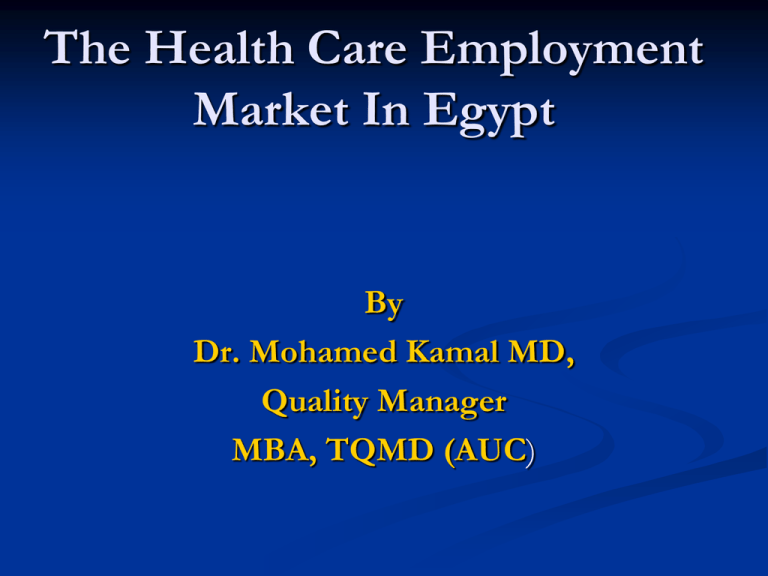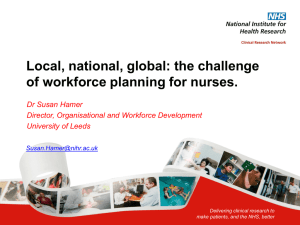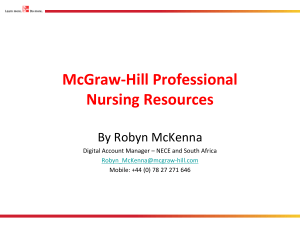Dr. Mohamed Kamal - Health Professions
advertisement

The Health Care Employment Market In Egypt By Dr. Mohamed Kamal MD, Quality Manager MBA, TQMD (AUC) What is the labour market for health workers The labor market for health professionals is derived from and directly connected to the market for health and medical services The process for delivering health-care services requires the input of health workers, along with other inputs, such as medicines, equipment and other health-care supplies. Clinics and hospitals have a demand for health workers in order to produce health services, which are demanded by purchasers of health care. This point is often overlooked. The demand for health services is linked to the willingness of the government, patients, health insurers and other purchasers of health care, such as donors, to fund health services. Egypt’s Health Care System Public/Private/ Social Health Insurance NHS style government/public health system Social Health Insurance (employer based and school children) Private Sector % of GDP spent on Health: 6.3% (Canada: 10%) in 2006 – WHO estimates Private expenditure on health as % of total expenditure on health (58.6%) – WHO estimates The growing gap between the supply of health care professionals and the demand for their services is recognized as a key issue for health and development worldwide. Policy-makers, planners and managers continue to seek effective means to recruit and retain staff. One way to achieve this is to develop and implement effective incentive schemes. What is the Labour Market? Local? Regional? International? Today’s labour market? Tomorrow’s labour market? The labour market in 30 years from now? What Does the Labor Market Need? Knowledge: Most up to date and Relevant education and learning Skills: to use the knowledge and to mitigate and manage the challenges of work and life Attitude: Positive – to work and develop individually, within groups and communities and probably within the world as a whole. What are the Skills needed? Strong thinking, communication, entrepreneurial skills, adaptability, labour market skills, problem solving, decision making, team work, responsibility and interpersonal skills Can this be a negative edge in traditional hierarchical work structures? Human Resource Challenges in Egypt Egypt’s Health reforms in hospitals and the Family Health Model require changes in staff skills and mix. Workforce distribution poorly allocated: Between urban and rural areas Between primary, secondary, and tertiary care Among different specialties New management skills due to increasing complexity of health systems. The need` for linking training programs to actual staffing needs. 10 Do you know who this is? IMHOTEP Egyptian Born 27th century BCE Considered to be the first achitect, engineer and PHYSICIAN! Future Outlook of Healthcare Industry It is a unique industry!! : The healthcare industry includes : Establishments ranging from small-town private practices of physicians who employ only one medical assistant Busy inner-city hospitals that provide thousands of diverse jobs. Combining : Medical hi-tech Human touch Communication tools Diagnostic facilities Treats and administer care around the clock to the need of million of all social classes of people and to the widest age group from intra-uterine to terminally elderly ill . Outlook of HC employment : In US; Healthcare will generate 3.2 million new wage and salary jobs between 2008 and 2018, more than any other industry, largely in response to rapid growth in the elderly population. In Egypt; Many job openings should arise in all healthcare employment settings as a result of the new strong movement towards investment and/or stimulation package for this sectors. Also the big NGO organizations. New comers from abroad THE EXPECTED INCREASE OF HEALTH BUDGUT TO 12% WITHIN 4 YEARS The healthcare Opportunities Medical tourism the private-public partnerships new legislation and the strong contribution of the non-governmental organization in the field of healthcare Sustain its growth pace There is a believe that healthcare industry is expected to sustain its growth pace in near future owing to the escalation of the burden of diseases. And inappropriate demographic balance which will create demand for better healthcare facilities. GDP Growth & health conscious : These countries have become more health conscious, leading to an increase in the usage of more expensive therapies and high innovative products.. A wide range of economic and structural reforms were adopted in the region while public and private investment projects were launched to pursue economic diversification and human capital development as well as investment in oil and gas, infrastructure, and other economic sectors. Employment Demand for tele-medicine expert / data transfer & management expert / IT expert / healthcare economists / actuarial expert / Hi-tech maintenance will rise due to the fast growing of healthcare insurance sector including the social and the private one. Hospitals will be the slowest growing segment within the healthcare industry because of efforts to control hospital costs and the increasing use of outpatient clinics and other alternative care sites Optimistic future : The pharmaceutical industry, information technology and distribution are expected to grow. Moreover, biotechnology and R&D are expected to grow but at a lower rate. According to the Egypt Human Development Report13, health professionals are concentrated in urban centres, such as Cairo and Alexandria, and Upper Egypt. Study results reveal that, in these areas, private and parastatal health facilities are practically nonexistent. Available public health facilities, in turn, are often poorly equipped, causing stress and frustration to health professionals. Moreover, these health facilities do not offer possibilities for further professional training and specialization Health Professionals in Egypt? 20 Example of Egypt Workforce Analysis Results Results of Workforce Assessment in one of the Pilot Governorates 21 Current Staff Profile Staff Composition 22 Current Staff Profile Registered vs. Actually Working Staff 23 Why is there a shortage of nurses in Egypt and globally The composition of nurse supply in selected EMRO countries (2005) All nurses in countries of the region with the exception of Egypt, Yemen and Afghanistan have a minimum of 2 years post secondary education. If the definition of nurses is restricted to qualified nurses (nurses who have at least 2 years of post-secondary/ high school education) then the ratio in Egypt drops to 0.18 nurses per 1000 population, which is an extremely low ratio by any standards. Different types of nurses There are 3 types of nurse education and predominantly three types of nurses in Egypt today: High school nursing education which (referred to as secondary level school in Egypt) Technical institute nursing education (2 years of post high school education) University nursing education (4 years of post high school education) Shortage according to Economists and the rest of the world -Conservative culture: women don't want to become nurses or work as nurses in Egypt The problem of the nurse image as a barrier for women to become nurses seems to be no longer an issue (except perhaps in Upper Egypt to a limited extent) -Government don't pay nurses enough to attract them to work with great workload Few nursing schools- not enough nurses being produced Nurses leave Egypt to work in the the Arabic/Persian Gulf On the Road to Professionalism: Future Past, Present and Sporadic Unplanned Training. Multiple Level of Education Absence of Practice Law. Inadequate Appearance. Non coordinated Efforts for Improvement. Limited Cooperation between MoH and MoEd. Maldistribution THE NURSE WE NEED Upgrading nurses' knowledge, performance and attitude to comply with International standards capable of working in the region and internationally, consequently reflecting positively on nurses image. Building their knowledge and performance excellence on research evidence, community needs and international connections. Current Status of Workforce Qualification Total numbers of nurses registered in Syndicate till Year 2006 201,669 Bachelor Degree 6,2 % Technical Institute Degree 0.9 % Secondary Technical Institute Degree Others 85 7.9 % % Current Status of Nursing Workforce With Respect to Int. Standards = 0.27% = 204,000 Deficiency based on international standards = 38,000 Required nurses by 2020 = 242,000 = Ratio of Nurses to population 260,000 Number of nurses in registry Required nurses by 2020 taking in consideration drop out rate of 4% Conclusion of Current Status – Statistics 2008 Current Nursing No. 204,000 Nurses MOH 165,000 nurse Current No. of Nursing School 240 Nursing Schools No. of Nursing School Graduates Annually 6500 Nurses No. of Nursing Faculties Graduates 1200 Nurses No. of Technical Institutes Graduates 1000 Nurses Annual dropout Ratio 4% from the total workforce (MOH Nursing) Considering Total No. of Beds - MOH International ratio Others 39,000 nurses Primary Health Care 96,000 beds 5199 facilities 45,000 (-) nurse 51,987 (+) nurse Numbers of Faculty of Nursing Graduates From 2003 to 2008 Alarm!! Graduation Year Graduates Numbers 2003 2175 2004 2379 2005 2352 2006 2302 2007 1287 2008 1200 Figure Illustrating Deficiency in Some Governorates Total Def Primary Def Curative 6,577 4,591 4,006 2,973 2,102 1,058 1,760 KSh 1,842 Qena 1,581 890 487 2,447 360 206 471 DK Sohag Luxor Manpower Distribution Nurse/Patient Ratio Physician/Patient Ratio 1:250 1:400 Year 2005 Nurse/10000 Population for Enrolled 14.82 Nurse/10000 Population for incharge 13.36 Year 2003 Why does anyone work in the public sector? Nurses prefer the public sector after they get married because of much less work demands, no one can fire you, you have health insurance and pension benefits, and better hours(Nurse 5) **The private sector presence is strongest in Cairo and Alexandria; however it is not as prevalent in rural governorates and therefore, it is not always a viable option for a nurse depending on her geographical location If we continue to do things the way we did we will remain where we are”. “ Stephen Covey Where do nurses work? About 80% of nurses are employed by the public sector in 2008 (with some dual employment) Salary levels are determined by the central government as part of overall public sector payment structure National Demand for Nurses Bifurcated Demand Public sector demandThe salary of a nurse in the public sector: LE 165 for a Diploma level nurse (nurse with high school nurse) LE 250 for a Bachelor level nurse (nurse with 4 years of post high school university education). With incentives,, the salary of a nurse in the public sector rarely exceeds LE 1000. Private demand for nurses –The salary of a nurse in the private sector: starting salaries advertised at LE 800 and -up to LE 7000 for qualified and experienced bachelor level nurses in private hospitals in Cairo and Alexandria The supply of nurses- willingness to work MOHP sources believe that there is (leakage); 7000 nurses exit the market for various reasons (work abroad, stay home or work in another sector) The resultant increase of 3000 nurses every year to the nurse labor force is believed to be lower than what is needed. (MOHP Director of Nursing) 4% leakage is an educated guess by the director of nursing- no data! Education Output Projection Number of Institutes 60 40 30 25 12 Data Includes post primary and post secondary Expected number of Graduates Year 21,000 2020 12,000 2015 10,000 2012 3906 2010 1394 2009 Future Outlook - Employment : Demand for dental care will rise due to greater retention of natural teeth by middle-aged and older persons, greater awareness of the importance of dental care, and an increased ability to pay for services. Dentists will use support personnel such as dental hygienists and assistants to help meet their increased workloads. - Continuing Education and Performance Holland Hull U North Spanish Training through Foreign Experts Spain Thailand Overseas travel Central Cont Education 2500/year Maintain performance On site training Hosp and PHC 10,000/year Nursing Fellowship Program 30% of workforce Hospital nurses 5% PHC Gaps are challenging The most significant gaps the developing countries will face are : retaining the best healthcare providers. Adaptation of the very advanced technology The new model of distant treatment will make earnings for the ordinary physicians very difficult and most of the well trained doctors and nurses and hi-technicians will spend their productive lives outside our countries, most properly in Europe and in turkey. Challenges Glaring gaps and inequities in health persist both within and between countries, underscoring our collective failure to share the dramatic health advances equitably. At the same time, fresh health challenges loom. New infectious, environmental, and behavioural risks, at a time of rapid demographic and epidemiological transitions, threaten health security of all. Health systems worldwide are struggling to keep up, as they become more complex and costly, placing additional demands on health . Professional education has not kept pace with these challenges, largely because of fragmented, outdated, and static curricula that produce ill-equipped graduates. The problems are systemic: mismatch of competencies to patient and population needs; poor teamwork; persistent gender stratification of professional status; narrow technical focus without broader contextual understanding; episodic encounters rather than continuous care; predominant hospital orientation at the expense of primary care; quantitative and qualitative imbalances in the professional labour market; and weak leadership to improve health-system performance. Laudable efforts to address these deficiencies have mostly floundered, partly because of the so-called tribalism of the professions—ie, the tendency of the various professions Regional markets Egyptian Nurses working in the Gulf In 2007, Egypt had a general unemployment rate of 11.2%, male unemployment rate of 7.10% and female unemployment rate of 24.3%. Therefore, training nurses for export could be an opportunity because of the benefit to the Egyptian economy In addition to remittances, if nurses who leave are required to pay certain taxes to support nurses’ education in Egypt and compensate the government for the free education they received, this could also be useful for the health sector. It would also make sense for the government in this case to encourage and regulate private nursing education.. Medical Tourism Government acted already Private sector opportunities Government acted already Privatization and tax allowances Pull Increasing demand for health professionals in Gulf countries Much higher salaries for all groups of health professionals in receiving countries Better practical education and career opportunities in receiving countries Supply of health professionals Between 2001 and 2008, the number of nursing staff increased by almost 24,000 (from 83,879 to 107,717); the number of pharmacists increased by about 8500 (from 3,375 to 11,953); and the number of physicians increased by roughly 11,000 (from 40,422 to 51,491). The number of dentists increased the least, with 3,000 more in 2008 compared to 2001, from 5,770 to 8,85612. The total increase of medical staff did not result, however, in equal health coverage across the country. New 2003 labor regulations it seems important to examine the effect of the new labor law on employment, in particular on informal employment. Theoretically, one would expect the new law to enable employers to hire and fire workers more easily and hence to enable them to hire more workers formally. In the following section we test the hypothesis that the introduction of the new labor law has led to more formal private employment. 4. Remmember ? Treat people with disrespect. Keep them waiting unnecessarily. Steal their thunder by using their ideas without giving them credit. Say one thing then do the complete opposite. Break promises regularly. There are, however, quite a few common traits when it comes to being professional. This includes the following: 1. Competence. You’re good at what you do – and you have the skills and knowledge that enable you to do your job well. 2. Reliability. People can depend on you to show up on time, submit your work when it’s supposed to be ready, etc. 3. Honesty. You tell the truth and are upfront about where things stand. 4. Integrity. You are known for your consistent principles. 5. Respect For Others. Treating all people as if they mattered is part of your approach. 6. Self-Upgrading. Rather than letting your skills or knowledge become outdated, you seek out ways of staying current. 7. Being Positive. No one likes a constant pessimist. Having an upbeat attitude and trying to be a problem-solver makes a big difference. 8. Supporting Others. You share the spotlight with colleagues, take time to show others how to do things properly, and lend an ear when necessary. 9. Staying Work-Focused. Not letting your private life needlessly have an impact on your job, and not spending time at work attending to personal matters. 10. Listening Carefully. People want to be heard, so you give people a chance to explain their ideas properly. The more you put into practice the points listed above, the better your chances will be to create a positive reputation for yourself. This can ultimately translate into raises and promotions, chances to work on more assignments that you enjoy, less likelihood of being downsized when layoffs are being considered, and the respect of peers and senior management. You also benefit from feelings of increased self-worth and dignity. Plus you keep yourself marketable for the future. All in all, some very good reasons to as professional as possible. Other Staff Requirements Staff Type Current Required GAP Ratio Dentists 92 45 47 2.0 Pharmacists 287 117 170 2.5 Admin Staff 1707 1128 579 1.5 Dentistry 73 10 63 7.3 Lab. 107 49 58 2.2 Radiology 221 16 205 13.8 Medical Technicians 68 What are typical causes of high turnover? Stress on the job: Shift rotation Mandatory overtime Physical demands Safety issues Psychological demands Aging workforce / retirement Factors cited as contributing to high turnover of RNs Poor pay and benefits Poor relationships with physicians Lack of voice in patient care issues Mandatory overtime and lack of scheduling flexibility Patient load and pace of work due to understaffing Lack of access to supervisors and mentors Documentation requirements Challenges and opportunities Labour mobility in the region is structurally driven by demographic, social and economic differentials between labour abundant and resource abundant countries. While the causes of labour mobility can be perceived as challenges to the development of the region (for instance, high population growth resulting in high youth unemployment), migration can be an importantpillar for local and national development policies, when mainstreamed into national development plans. Thus, migration and labour mobility can be part of a solution to development imperatives that is consistent with local governance and social models, while allowing individuals to achieve their full potential for the growth and development of the region. Egyptian Marketing? Selling Public Relations Advertising Promotion (Almost) Anything Can be Marketed Consumer Goods and Services BusinesstoBusiness Marketing Not-ForProfit Marketing Idea, Place, People Marketing BE THE CHANGE YOU WANT TO SEE IN THE WORLD GHANDI







